NYSAC News
NEW YORK STATE ASSOCIATION OF COUNTIES
WINTER 2023 Legislative Guide



PERMA is the trusted source to more than 600 public entities across New York State for not only strategic Workers’ Compensation coverage plans but also proactive and comprehensive workplace solutions.
Let PERMA be your source for:
better safety and risk management personalized service and support solutions for today’s workplace needs
Membership in PERMA includes access to valuable training programs, services and benefits that elsewhere are additional expenses.
Member Spotlight: STEUBEN COUNTY
“We were with a third party administrator that didn’t provide much support or solutions and were actively looking to change. PERMA understands the pressures of local government and was creative in finding a solution that worked for us as a self-insured pool.”
 – Jack Wheeler, County Manager & PERMA Board Member
– Jack Wheeler, County Manager & PERMA Board Member
PERMA’s diligent review of Steuben County’s prior Workers’ Compensation claims resulted in recovering for the county $400,000 in overpayments. They have been a PERMA member now for more than 9 years.











Cost Savings. Carbon Reduction. Community Benefits.

NYPA can help your town chart its clean energy path. We take into account your need to balance cost, sustainability and community goals – for the clean energy solution that fits your town best.


Our experts bring proven audit, planning, procurement and implementation solutions – together with unparalleled knowledge of New York State regulations and incentives. Talk with us about how we can help streamline the bidding process with preapproved developers to save you time and money.

Let our project managers and engineers serve as an extension of your team.
Learn more about all our clean energy offerings. Consider exploring the best options with us!
To learn more, provide your information at nypa.gov/services123
EnergySolutions@nypa.gov
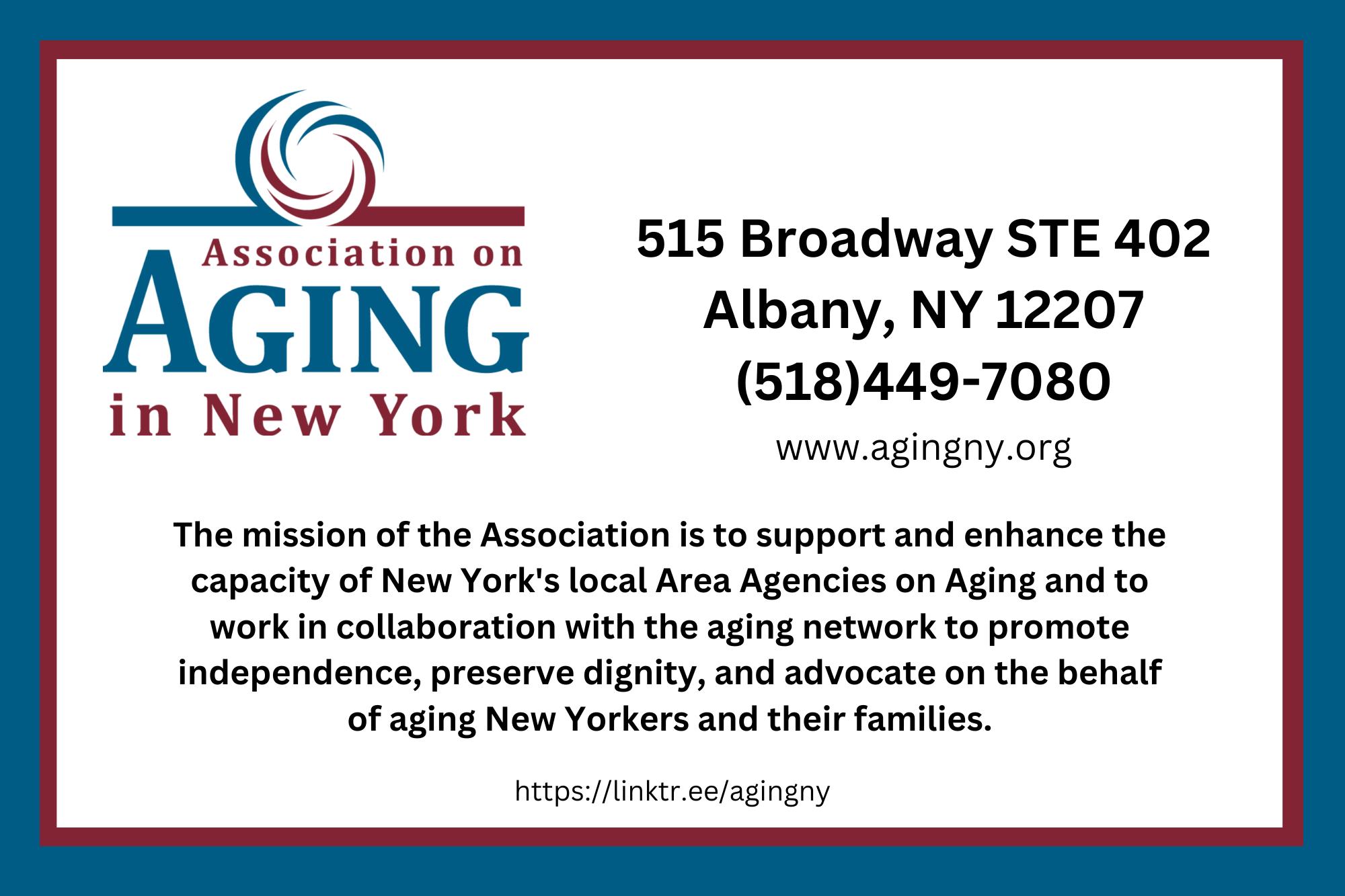
Michael E. Zurlo Clinton County President
Hon. Daniel P. McCoy Albany County President-Elect
Hon. Benjamin Boykin II
Westchester County
First Vice President
Hon. Philip R. Church Oswego County
Second Vice President
Hon. Martha C. Sauerbrey Tioga County
Immediate Past President

Hon. Luis A. Alvarez, Sullivan County

Hon. Steven Bellone, Suffolk County
Mr. Christopher Ellis Jr. New York City
Mr. Richard R. House, Wayne County
Hon. Beth A. Hunt, Hamilton County
Hon. Margaret M. Kennedy, Otsego County
Hon. Steven M. Neuhaus, Orange County
Dr. Kevin Watkins, Cattaraugus County
Hon. PJ Wendel, Chautauqua County
Hon. Herman Geist, Esq., Westchester County
Hon. A. Douglas Berwanger, Wyoming County
With little fanfare this past fall, the NYSAC Board of Directors updated the Association’s mission statement to more accurately represent what we do, who we do it for, and the times that we are in right now as local government leaders.
NYSAC’s mission is to foster excellence in county government and unite the voice of New York’s county leaders. We are NYSAC. We are the united voice of New York’s counties!
I wanted to raise this topic here because I feel it’s important for NYSAC members to know how dedicated this Association is to supporting its members professionally and advancing our priorities in halls of power in Albany.
In resetting our mission, the NYSAC Board of Directors explored the past, present, and future of our collective work with and for the counties. We identified key performance indicators, critical success factors, crucial stakeholders, and more than 100 of the most pressing issues facing counties. This work was used to set NYSAC’s mission, direction, and activities for years to come.
The board discussed answers to two very specific questions: why were we created? and why have we been successful? The discussion was lively, and the answers were a powerful testament to our members, our staff, and those county leaders who came before us over the past 100 years.
Throughout its history, NYSAC evolved along with our counties, helping them meet their challenges. As local governance became more complex, the Association became more important than ever. We have come to be the one and only “Official Voice” of all counties, large and small. This is particularly important as we work on federal and state policies in ways that benefit counties and the New Yorkers we serve.
NYSAC’s success comes from our ability to unify all counties, regardless of size,
region, or political ideology, around the shared interests of a diverse state. Our collaborative approach empowers county officials to advocate for their needs, build professional networks, and learn from each other. The Association’s talented, dedicated, and enthusiastic staff ensures state leaders understand county concerns, and effectively uses fact-based data-driven processes to influence public policies.
Counties face a wide range of pressing challenges—today and in the future. NYSAC has a strong reputation for helping its members turn these challenges into opportunities. We discussed these challenges and opportunities, and they provide a solid foundation for thinking about, and planning for, how the Association can best support its members over the next several years.
NYSAC, at its core and from its beginning, is an Association of county leaders. We were created by and for county officers, and every day, your NYSAC staff asks how they can be a better resource to you.
Over the last year as we conducted our review of NYSAC’s core mission, one fact kept appearing over and over as we talked to members and stakeholders: Our past successes have come from our ability to unite our diverse counties and develop a unified message to state leaders. Today’s divisive political environment make that unity more important than ever before.
As we begin this new year, I am proud to be President of this Association and I look forward to working with all of you to make our communities and our state better and stronger for the New Yorkers who come after us.






(partial listing)
Stephen J. Acquario, Esq. Executive Director

Karen Catalfamo Office/Financial Manager
Patrick Cummings, Esq. Counsel
Jackie Dederick Records Manager
Patricia Gettings Assistant to the Director
Ryan Gregoire Legislative Director
Alexandra LaMonte Legislative/Policy Coordinator
Mark LaVigne Deputy Director
Dave Lucas Director of Finance & Intergovernmental Affairs
Juanita Munguia Business Development Manager
Tom Oldfather Communications Manager
Kate Pierce-Nimz Multimedia Specialist
Jeanette Stanziano Director of Education & Training
As the only statewide association representing every county in New York State, we are the official voice for county governments and have been for nearly 100 years. We are very proud of this role and take our job seriously. Every day, we strive to provide our county officials with meaningful resources so that they can better serve the public.
Our upcoming Legislative Conference is a prime example. We have organized this summit to provide attendees with meaningful information that they can take back to their counties and share with other legislators, supervisors, and department heads.
We will also have a renowned economist from the Bank of New York Mellon give a presentation to help us better understand what is happening in today’s economy, including our continued pandemic recovery, inflationary pressure, lingering supply chain constraints, workforce shortages, and escalating interest rates. He will tie these factors together and discuss how they could impact local conditions and affect our predictions for the coming year.
Onondaga County Executive
Ryan McMahon and his economic development leaders will host a conference-wide panel event to discuss what it took to land one of the largest economic development projects in the state’s history. Micron’s decision to build its next microchip fabrication facility in Onondaga County will have a transformative impact beyond the Central New York region. They will discuss the planning and leadership that went into making this location prime for the Superbowl of economic development projects.
We will also host a timely and engaging discussion about the state of the transition to electric vehicles and the expansion of EV charging station infrastructure across New York. We will close out the event with two postconference opportunities: a required emergency management training, and a primer on an innovative new mental health program.
In between, we will have a dozen committee meetings, more than two dozen workshops, and numerous networking events designed specifically for our county members to connect with their colleagues on best practices, solutions, and opportunities to ask questions that help them be better local leaders in their communities.
We are your Association! And our mission is to foster excellence in county government.
I look forward to seeing you at the NYSAC Legislative Conference and to working with you throughout the year.
Stephen J. Acquario, Esq. NYSAC Executive DirectorNYSAC News
NEW YORK STATE ASSOCIATION OF COUNTIES
Advertise
Contact
Michael E. Zurlo
Publisher
Stephen J. Acquario
Managing Editor
Mark F. LaVigne
Editor
Tom Oldfather
Designer
Kate Pierce-Nimz
Advertising Staff
Juanita Munguia
the
with
NEWS MAGAZINE 515 Broadway, Suite 402, Albany, New York 12207

Phone • (518)
The advertisements and articles in NYSAC News in no way imply support or endorsement by NYSAC for any of the products, services or messages conveyed herein.



For nearly 100 years, NYSAC has worked to foster excellence in county government and unite the voice of county leaders in our State Capitol. In support of that mission, the NYSAC Legislative Team works together to analyze legislation, develop lobbying action plans, and coordinate NYSAC’s legislative agenda to advocate for counties with a unified voice. Each year, the NYSAC Legislative Team follows a timeline of budget and legislative work to be accomplished on behalf of our members. While the timeline typically aligns with the state budget process and legislative calendar, this year has been and will continue to be a little bit different.
While counties have been busy preparing and passing a county budget filled with many unknowns, so too has the State and the Governor’s Office.
Following the 2022 Fall Seminar, NYSAC’s 12 standing committees and its IT Task Force developed, discussed, and adopted a series of resolutions that became the basis of NYSAC’s 2022 Legislative Program, including our legislative agenda, fact sheets, and whitepapers.
Last year, the legislative and communications team spearheaded an ambitious overhaul of the county advocacy platform to make it easier to digest and understand. The redesigned format was met with significant positive feedback from external stakeholders –which has allowed this new format to continue for 2023. The result of that work resulted in our 2023 Legislative Program, a summary of NYSAC’s entire legislative agenda, broken-down by issue areas impacting county government service delivery. You can download the 2023 Legislative Program at nysac.org/ stateadvocacy.
Once finalized, NYSAC expands on the Legislative Program to provide supporting material and data for each item. We then schedule meetings with representatives from the New York State Division of Budget (DOB) to share our members’ budgetrelated requests as well as meet with senior leadership in both chambers of the State Legislature.
January marks the beginning of the New York State Legislative Session. The session begins the first Wednesday after the first Monday of the New Year. The opening is usually marked by the Governor's delivery of the "State of the State Message" in Albany, although this year the Governor opted to deliver her annual address a week later. In a return to the historic delivery of this address, Governor Hochul spoke to New Yorkers from the people’s house – the Assembly chambers in the Capitol building.
In her speech, the Governor provided a general outline of the priorities and programs she wants the Legislature to address during the year ahead. The Governor must submit her Executive Budget Proposal to the Legislature, along with the related appropriation, revenue, and budget bills, February 1st since it’s a gubernatorial election year.
Once the Governor’s Executive Budget Proposal is released, NYSAC’s Legislative Team identifies key issues for counties contained in, or excluded from, the Executive Budget Proposal.
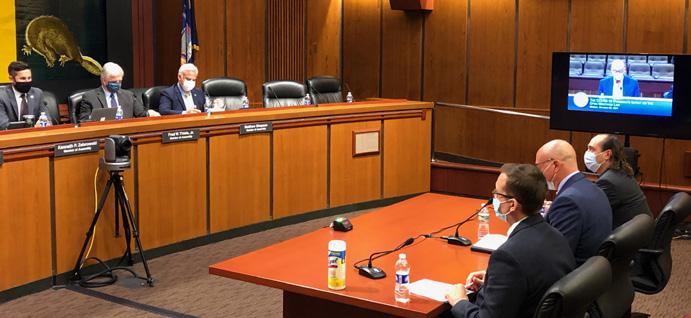

The Legislative Team then develops a lobbying plan for each issue. This involves analyzing the bills, obtaining county feedback and data, and organizing strategic meetings with the Legislature, staff, DOB, and the Governor’s Office.
If there are any major county-involved items addressed by the Executive Budget Proposal but not part of our Legislative Platform, the Legislative Team drafts resolutions to be presented to the proper standing committee during the Legislative Conference in March.
While the budget process continues, new bills are introduced daily by members of the Legislature. The Legislative Team reviews daily introductions, reviews committee reports, and responds accordingly with memos in support or opposition.

At the conclusion of the NYSAC Legislative Conference, the Legislative Team sends the adopted resolutions to the Governor, Senate and Assembly leadership, each member of the Legislature, agency heads, Congressional Membership and any/all appropriate staff.
In February, the Legislature creates Legislative Budget Standing Committees and commences Joint Legislative Budget Hearings. The NYSAC Legislative Team prepares testimony to be presented at the Local Government Hearing and coordinates meetings with the Senate and Assembly leadership and staff.
The Governor typically releases 21-Day Amendments and 30-Day Amendments to the Executive Budget Proposal bills by the end of February, depending on when initial bills are introduced. Once the 30-Day Amendments are released, the Senate and Assembly release their own budget proposals. The Legislative Team identifies key issues for counties addressed in the Legislature’s budget proposals and revises the lobbying plan for each issue as needed.

The Executive State Budget must be passed by April 1. Upon adoption of the final State Budget, the Legislative Team immediately prepares a full analysis of the final State Budget to provide to NYSAC members.
Budget priorities that were not completed in the final State Budget are transitioned into non-budget legislative priority items that we lobby the Legislature on for the remainder of the session.
As the session concludes during the month of June, the Legislative Team analyzes all legislation that has passed both Houses and measures each bill’s impact on individual member counties.
Once the analysis is complete, the Legislative Team compiles the “Passed Both Houses” report, which is sent to NYSAC members. This report explains all the key items from the final State Budget along with a description of all the bills that have an impact on counties. Our team continues to update the report through the end of the calendar year.
Once bills are transmitted to the Governor’s Office, NYSAC drafts letters to the Governor’s Counsel to report counties’ support or opposition to the pending legislation.
Throughout this process, we encourage our members to stay engaged in the process by attending our Legislative Conference, visiting the Advocacy section of the NYSAC website, reading our regular email updates and by following NYSAC on Twitter and Facebook (@NYSCounties) for the latest news and updates.

County elected officials have become accustomed to managing the delivery of essential services while balancing taxpayers’ demands for frugality with public resources. The last few years have been challenging, seeing lows and highs for county finances.
County officials have managed through difficult fiscal times before, so a prudent approach to budgeting has become a staple. In addition to being subject to the whims of the economy, counties are also subject to the whims of their federal and state government partners.
While New York is considered a strong home rule state, in practice that is not always the case. Counties in New York are subject to some of the most stringent cost sharing requirements to support state programs anywhere in the country. This limits local flexibility to manage budgets and taxation.
A strong state partnership is essential to help reduce pressure on local taxation and making New York more affordable. In many years the county motto in dealing with state elected leaders can be summed up as “do no harm”. As the State Legislature convenes this year and negotiates the parameters of the SFY 2024 budget we hope our state elected leaders will, at the very minimum, remember the “do no harm” mantra and dig deeper to actually reverse existing state mandates.
In some years, counties are forced to step backwards, and in other years, they’re able to stride forward. Positive years for counties are usually precipitated by the state taking more fiscal responsibility for their own programs, providing more home rule authority to counties, or allowing more local revenue options to help pay for state and local services in the least burdensome manner possible.
In these positive years, counties often have room to bolster or restore local services and reduce pressure on the property tax levy. In 2023, in the face of the highest inflationary pressures in 40 years, nearly every county in the state cut their property tax rate, with the average rate dropping by 7.1 percent. In addition, the average county property tax levy change was just .6 percent, with 31 counties holding the levy flat or cutting it.
What helped facilitate this outcome was prudent budgeting by counties during the pandemic which helped many increase their reserves, a strong economy that bolstered sales tax receipts, the benefit of direct federal fiscal assistance through the American Rescue Plan Act, and the restoration of some state funding cuts made to counties during the pandemic and prior years including state support of county public health programs and the end of the state diversion of local sales tax to pay for state programs.
Even in these positive years, counties usually need to manage continued, or new, state cost shifts that have become mired in the county budget. During the Great Recession, as state finances deteriorated, hundreds of millions of dollars in annual costs were shifted from the state to counties, mainly in social services programs, and remain in place today.
Last year, the state settled decade-old litigation regarding stateset foster care rates paid to families but required counties and New York City to pay for the settlement on a permanent basis, adding $200 million in new annual costs. An expansion of Safety Net Program benefits added another $40 million in new annual costs for counties and New York City.
In the coming year, the state is signaling that recently-settled litigation related to the hourly rate the state sets for attorneys who provide counsel to indigent defendants (a federal
constitutional requirement placed on the state) will be paid entirely by counties, doubling current costs, and potentially building in $150 million in new recurring costs.

As we move forward with this annual ritual of give and take, we encourage state officials to remember the single biggest mandate relief initiative the state provided for local property taxpayers starting back in 2005 and expanded in 2015, the capping of county Medicaid costs.
In 2005, Governor Pataki and legislative leaders enacted a cap on county Medicaid cost growth of no more than 3 percent annually. This cap was determined to be necessary after the state greatly expanded Medicaid coverage and benefits in 2002. The expansion led to double digit property tax increases in many counties, with 33 counties finding it necessary to also raise their local sales tax to support the new Medicaid costs imposed on them.
In 2015, Governor Cuomo and the Legislature agreed to lower the county Medicaid growth cap to zero percent, capping county and New York City Medicaid costs at $7.6 billion annually thereafter. Even with this new zero percent cap, the counties of New York are mandated to pay more for the state’s Medicaid program than all the remaining counties in the country combined. For most counties nationwide, Medicaid payments are voluntary, and are made to draw down federal matching dollars that help subsidize county-owned hospitals, nursing homes and clinics.
These two Medicaid caps reduced pressure on county budgets and property tax levies. The Medicaid expansion of 2002 led to annual average increases in county property tax levies of 7.3 percent per year in the years leading up to the first cap. Increases were curtailed after the first cap was enacted into law.
Between 2005 and 2015 the average change in property tax levies was 2.2 percent and after 2015 the increases have been lowered to 1.2 percent per year on average. These annual state savings for counties have been augmented by federal savings through various enhanced Medicaid matching rates, including from the Affordable Care Act and emergency COVID relief legislation. These federal savings are required under federal law to be shared with counties and they have lowered county Medicaid costs by hundreds of millions of dollars annually (unfortunately the COVID federal enhancements are being reduced effective March 31st and will expire completely by the end of 2023).
A key priority for counties every year is to work with our state government partners to reverse old cost shifts, prevent new state cost shifts and unfunded mandates, and maintain the federal fiscal savings provided by Congress. When these things happen, counties have more control over their own resources and will have the ability to lower the local tax burden and bolster desired services.
Since 2013 the program has helped over a dozen counties streamline purchases, pay bills and earn over $800,000 in cash rebates.
The Payment Solutions Program, which is a special type of credit card, can help ease the the purchase of supplies, furniture, construction materials, utilities and much more, all while saving staff time and money.









Allegany County
Scott A. Cicirello, Sheriff
Broome County
Louis P. Augostini, County Legislator
Erin V. Micha, County Legislator
Fred Akshar, Sheriff
Cattaraugus County
Darrell T. Klute, County Clerk
Chemung County
Joseph Donovan, County Legislator
Lawana Morse, County Legislator
James Palmer, County Legislator
Steven Pickering, County Legislator
Michael L. Saglibene, County Legislator
Brent Stermer, County Legislator
Chenango County
Cammie Wyckoff, Town Supervisor
Franklin County
Justus H. Martin, County Legislator
Nedd J. Sparks, County Legislator
Elizabeth M. Crawford, District Attorney
Jay D. Cook, Sheriff
Fulton County
Michael J. Poulin, District Attorney
Jefferson County
Peter R. Barnett, Sheriff
Montgomery County
Herbert T. Allen, County Legislator
Maria Flint Kowalczyk, County Legislator
Oneida County
Mary E. Finegan, County Clerk
Onondaga County
Tobias Shelley, Sheriff
Ontario County
David J. Cirencione, Sheriff
Orange County
Paul Arteta, Sheriff
Putnam County
Kevin M. Byrne, County Executive
Erin L. Crowley, County Legislator
Greg Ellner, County Legislator
St. Lawrence County
Benjamin E. Hull, County Legislator
Glenn Webster, County Legislator
Steuben County
Nick Pelham, County Legislator
Suffolk County
Vincent Puleo, County Clerk
Ulster County
Jen Metzger, County Executive
Wyoming County
Robin Lawall, County Treasurer
David Linder, Sheriff

In addition to NYSAC’s broader legislative program, which outlines a broad array of policy proposals that impact nearly every aspect of county government, NYSAC also develops and advances a narrowed agenda of top legislative priorities based on the importance and magnitude of impact to county government operations.
This agenda features priorities that need to be addressed in the State Budget, as well as non-budget related priorities that require the attention of our state leaders. County leaders should be aware of these top policy priorities as they engage with their own state legislative delegation as well as representatives from the Governor’s team.
As mandated by federal case law, the state requires counties to provide legal representation to indigent persons in each county Appellate, Criminal, and Family Court. These services are mandated under Article 18-B of the County Law. Counties contract with 18-B attorneys as public defenders for some cases. In other situations, counties employ public defenders and conflict defenders to augment 18-B assigned counsel attorneys. The state sets the pay rates for the assigned counsel program and the state has recently settled a lawsuit that doubles the 18-B rates for counties. While 18-B attorney rate increases may be warranted in certain areas to ensure quality public defense services for the poor, it is the state, not county taxpayers, who bear the responsibility for funding them.
Counties all over New York are facing a hiring crisis. Since the onset of the COVID-19 pandemic, recruiting and retaining necessary talent has become increasingly challenging. Current restrictions by NYS Civil Service Law make it difficult for local governments to compete for scarce workers. Perspective employees demand a system that is more flexible, and which offers a faster hiring process. To address these challenges, NYSAC has developed a series of recommendations to reform the Civil Service System in New York State. These include proposals to:
• Eliminate the competitive status for any position that requires the applicant to hold a valid professional license issued by the state,
• Eliminate the need for applicants to cross-file in adjacent municipalities to have their test scores counted for the same title in multiple jurisdictions,
• Grant local governments the option for continuous recruitment where possible. In instances when continuous recruitment is not possible, exams may be offered every two years regardless of the status of existing lists,
• Allow tests to be administered at the local level. Consider changing all or certain subsets of exams to pass/fail,
• Amend Public Officers Law §3 to allow for home rule authority to set employee residency rules,
• Expand the acceptable zone of “band scoring” of Civil Service examinations, thereby accessing a larger pool of candidates,
• Disqualify applicants from Civil Service eligible lists who are clearly inappropriate for a role in law enforcement or corrections as evidenced by a failed background check or psychological examination.
Counties have been unable to conclude a long-running disagreement with New York State over how much emergency federal Medicaid assistance (eFMAP) from the Affordable Care Act (ACA) is still owed to counties for SFY 2017, 2018, 2019, 2020, 2021, and 2022. Counties also recognize that COVID eFMAP benefits are also owed to counties for unreconciled calendar years of 2020, 2021, and 2022. NYSAC believes that counties and New York City are owed substantial amounts in federal Medicaid savings that have been withheld by the state.
Individuals have the right to mental competency prior to standing trial, but the current system places undue and often unrealistic burdens on localities that serve neither patients nor taxpayers.
• Reform CPL Part 730 by enacting A.8402 (Gunther) / S.7461 (Brouk) (2021-2022 Session Bill Number).
• Create a pilot program for jail-based restoration by enacting A.7061 (McDonald) / S.9133 (Mannion) (20212022 Session Bill Number).
These top policy and budget priorities combined with the rest of the NYSAC’s 2023 Legislative Program are the foundation for our advocacy agenda for 2023. We encourage all members to engage with their local state legislators on these issues in the coming months and to stay tuned for additional information and advocacy opportunities from NYSAC.

The annual County Legislative Program includes a series of reform proposals developed by county delegates, with a goal of making New York a better, stronger and economically viable state in which to live, work, and raise a family.


The program includes proposed policies and legislation to restore local control over sales tax, invest in public health, and help counties deliver services with improved efficiency and lower cost to local taxpayers.
The components of the Legislative Program reflect the need for specific state action.
Read the full 2023 Legislative Program at:
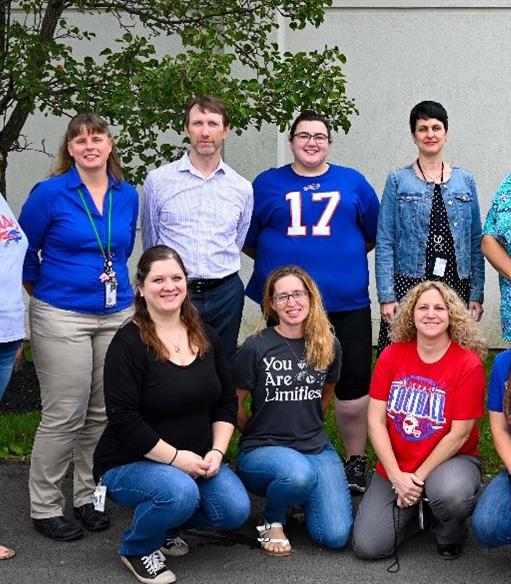
www.nysac.org/stateadvocacy

For more than 25 years, NYSTEC has served as a trusted advisor to government, helping our clients envision how their operations can be transformed by technology.




NYSTEC understands a county’s committment to operational e ectiveness, citizen access, technology quality, cost e ciency and public safety.




Our OGS contract makes it easy for counties to engage us quickly.

Centrica Business Solutions monitored the performance of the equipment for a period of time to make sure we were achieving the projected savings and efficiencies. The project was delivered on budget, everyone is happy, and the results are coming through.”



The 1963 landmark United States Supreme Court decision of Gideon vs. Wainwright was the first case to recognize the right to an attorney—regardless of an individual’s ability to afford an attorney—as a federal constitutional right that applies to the states. Specifically, Gideon held that the federal constitutional right to counsel under the 6th amendment applies to the states under the 14th amendment right to a fair trial.

This right applied to people accused of felony level offenses. Expanding even further upon this right, the New York State Court of Appeals decision of People v. Witenski, decided in 1965, held that the right to counsel extends to all criminal matters. The dissent noted the difficulty in implementing such a rule where the assignment of an attorney was not governed or regulated in any way.
As a result, that same year the Legislature enacted Article 18-B of the County Law which codified the right to counsel in criminal matters.
In 1975, New York further expanded the right to counsel for parents in Family Court matters who were at risk of having their children removed from their custody or who had criminal matters pending through the creation of Section 262 of Family Court Act.
Now, representation includes matters in the Family, Supreme and Surrogate Courts involving custody and visitation, abuse and neglect, paternity, adoption, family offenses, termination of parental rights and certain civil contempt proceedings involving a violation of court order issued as a result of any of these enumerated proceedings. Judges are also granted discretion to assign counsel where they believe the Constitution requires it.
Today, Article 18-B of the County Law requires the counties to create and implement a plan to provide for assignment of counsel through either the creation of a public defender’s office, representation through private legal aid society or corporation, or a plan of the local bar association to provide and administer the assignment of private attorneys through a rotational basis or through a conflict defender’s office. Each county has varying methods of providing state mandated representation for the indigent that include one or more of the enumerated methods required under 18-B.
In 2021, there were 663,809 criminal filings in the Criminal State and Local Courts in New York, and 361,896 filings in the family courts of New York. These numbers are significantly lower than those prior to 2020, but this is likely the result of the court restrictions in place because of the COVID-19 pandemic.
Recognizing the growing need for state resources to help fund the implementation of quality legal representation for state mandated matters, several organizations began to advocate for state funding, including the New York State Bar Association (NYSBA), the New York State Defenders Association (NYSDA), the New York County Lawyers Association, and the New York Civil Liberties Union.
These organizations not only called for increased resources to assist in the investigation of criminal and family court matters, but equal pay for public defenders commensurate with that of district attorneys as well as caseload standards to enable attorneys to devote adequate time and resources to each individual case. In addition, the organizations called for a stateside agency to create and oversee standards of representation for the defense of the indigent.
In June of 2006, the Kaye Commission on the Future of Indigent Defense issued a report finding that “the indigent defense system in New York State is both severely dysfunctional and structurally incapable of providing each poor defendant with effective legal representation that he or she is guaranteed by the Constitution of the United States and the Constitution and Laws of the State of New York. … [and] has resulted in a disparate, inequitable, and ineffective system for securing constitutional guarantees to those too poor to obtain legal counsel of their own choosing.”

Nevertheless, change was not forthcoming until the NYCLU, on behalf of several named plaintiffs, brought a lawsuit against the state for systemic ineffective assistance of counsel resulting from the lack of funding, resources and oversight to public defense system of the state.

The lawsuit, Hurrell-Harring, et al. v. State of New York, while ultimately settled with the state providing supplemental funding of indigent defense in those named counties, eventually led to funding for state-wide implementation of the terms of HurrellHarring, including case cap standards, availability of resources
Additionally, the settlement solidified and expanded the role of the Office of Indigent Legal Services (OILS) to create and oversee state-wide standards of representation for all indigent legal defense of criminal matters. While this has resulted in a significant increase in the quality of representation for the indigent in criminal matters throughout the state, notably left out of the terms of the lawsuit was the rate of pay for assigned counsel attorneys who agree to handle Criminal and Family Court matters as set forth under Article 18-B of the County Law.
The rate as it stands is $60 per hour for misdemeanor and violation level offenses, and $75 per hour for felony and Family Court representation, a rate that has remained stagnant for 19 years. As a result, the number of attorneys willing to handle these cases is dwindling, and those who do handle them are taking on so many cases in multiple counties, that adherence to the standards of representation as created by OILS, is impossible.
Until the state agrees to fund the increase in the rates, the crisis that has been looming, will only continue to grow, a crisis that is detrimentally affecting the lives of the indigent and children of this state.

Mental Health First Aid is a valuable resource that can make a difference in the lives of the one in four Americans struggling with mental illnesses and addictions, including those experiencing suicidal thinking. This eight hour in-person training teaches people how to help people developing a mental illness or experiencing a crisis.
Individuals trained in Mental Health First Aid can help:


Break down the bias against people living with mental illnesses, addictions and suicidal thinking.
Reach out to those who suffer in silence, reluctant to seek help.
Let individuals struggling with mental illnesses and addictions know that support is available in their community.
Who can be a Mental Health First Aider?
Law enforcement
Corrections officers
Other first responders
911 Dispatch Staff
Human resources professionals

Nurses and other primary care workers
School and college workers
Faith community leaders
Caring citizens
What a Mental Health First Aider can do:
Defuse crisis
Promote mental health literacy
Combat the stigma of mental illness
Enable early intervention with recognition of signs and symptoms
Connect people to care
For more information on these crucial trainings, call or email Sara Boerenko: 518-853-3531 or sboerenko@co.montgomery.ny.us
This training has been sponsored by: Montgomery County, NYS Conference of Local Mental Hygiene Directors (CLMHD) and the Staff of NYSAC!


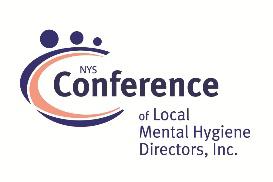

Be the first to know when CLMHD will offer its next MHFA Instructor Training Program! Scan the QR code below to receive CLMHD’s e-News, a weekly publication focused on behavioral health matters in counties, New York State, and nationally.


Our nation’s founders made it clear: individuals are presumed innocent until proven guilty. Despite this fundamental constitutional mandate, people who have a right to federal health benefits, such as Medicaid, Medicare or Children’s Health Insurance Program for juveniles, are stripped of those benefits when arrested and jailed for an alleged crime, before conviction.
This antiquated policy – known as the Medicaid Inmate Exclusion Policy (MIEP) – is a clear violation of the spirit of the equal protection and due process clauses of the Fifth and 14th Amendments of the U.S. Constitution. Additionally, it produces unfavorable health outcomes for individuals and communities, and places undue financial and administrative burdens on our local jails.
An end to the MIEP would rectify a serious inequity that allows individuals who can afford to post bail to remain on these health benefits, while rescinding these benefits from our most vulnerable residents, despite their presumed innocence. This is unfair, and we must end it.
County governments operate 2,875 of our nation’s 3,160 local jails, admitting approximately 10.5 million individuals across the United States each year. Many of these individuals have mental health or substance use issues, with serious mental illnesses being three to four times more prevalent among jail inmates than the general population. America’s local jail population includes an estimated 40 percent of people with a serious chronic health condition, 44 percent with a major mental health illness and 63 percent with a substance use disorder.
We also know that about 60 percent of people in our local jails are awaiting trial and have not been convicted of a crime. Individuals can stay in this pre-trial status for days, weeks or even months at a time. While many of these individuals would be eligible for federal benefits, the MIEP forces counties to bear the burden of their care and its cost. And even if they are released from jail quickly, it often takes weeks or months for their previous health coverage to restart, making immediate, uninterrupted access to vital treatment almost impossible.
The 118th Congress can advance bipartisan legislation that would greatly improve care coordination for those individuals suffering from mental health, substance use and/or other chronic health conditions by allowing continued access to
APPROVED AND PENDING SECTION 1115 MEDICAID IMD PAYMENT WAIVERS, AS OF OCT. 30, 2019

federal benefits. We urge our congressional partners to support the following bills that address the MIEP:
• The Medicaid Reentry Act, which would allow Medicaid payment for medical services furnished to an incarcerated individual during the 30-day period preceding the individual’s release. The bill was previously sponsored by Senators Baldwin (D-Wis.) and Braun (R-Ind.), and Representatives Tonko (D-N.Y.) and Turner (R-Ohio).
• The Due Process Continuity of Care Act, which would allow pretrial detainees to receive Medicaid benefits at the option of the state. The bill was previously sponsored by Senators Cassidy (R-La.), Markey (D-Mass.) and Merkley (D-Ore.), and Representatives Trone (D-Md.) and Turner (R-Ohio).
Consistent federal health benefits for non-convicted individuals would allow for improved care while decreasing short-term costs to local taxpayers and long-term expenses to the federal government. A more efficient investment of resources would improve post-release care coordination and result in decreased crime, reduced recidivism, and better outcomes for the overall health and safety of our residents.
It is time for Congress and the Biden administration to eliminate the harmful Medicaid Inmate Exclusion Policy.
For nearly 20 years, the former Warren County Jail has sat at the rear of Warren County Municipal Center, serving as little more than a large storage unit as its paint peeled and its history faded. The former jail became obsolete and unused when the county’s new jail and law enforcement center opened in October 2004.
Every few years, Warren County supervisors have discussed what to do with the building, but the costs of gutting a jail –abating the asbestos inside it, in particular -- were prohibitive.
Funding from the American Rescue Plan Act changed that this year, and the former correctional facility is on its way to a second life.
Overall, Warren County supervisors have awarded millions of dollars of the county’s share of ARPA funding to small businesses, first responders and non-profits since 2021.
But $500,000 of Warren County’s $12.4 million share of ARPA money was also put aside by county supervisors to be used to rid the former jail of asbestos and its metal bars, while potentially solving a regional problem at the same time.
The COVID-19 pandemic exacerbated an issue that Warren County and some other regional counties have confronted for a number of years – the increased costs of having autopsies performed. Counties must foot the bill when coroners or physicians order autopsies in certain types of deaths.
Warren County has seen its autopsy costs rise significantly in recent years, as the number of deaths increased, and costs rose to transport decedents to the regional forensic pathologist in Albany. Warren County’s costs for forensic medical services rose nearly 25% between 2019 and 2022, with 2022’s books not yet closed.
Those increases occurred in large part because Warren County has had to pay more, and transport remains farther, to have postmortem examinations performed amid shifting morgue and pathologist availability.
The Warren County Board of Supervisors has led the discussions to potentially convert part of the rehabilitated former Warren County Jail into a regional morgue, with the goal to work with neighboring counties to decrease costs and travel requirements for autopsies.

Warren County leaders have already discussed the idea with the region’s chief forensic pathologist. The concept also must get the approval of the New York State Department of Health before it moves forward, explained Kevin Geraghty, Chairman of the Warren County Board of Supervisors and Town of Warrensburg Supervisor.

“We’ve had some discussions with our neighboring counties and there seems to be some agreement this is a good idea worth looking into,” Geraghty explained. “It would be great if we can put the old jail to good use and save Warren County taxpayers and those from our neighboring counties some money at the same time.”
There is no timetable for the project, but Warren County Facilities Director Scott Rogers expects the demolition of the jail interior to be completed in early 2023. Green Island Group of Nassau County won the bid as general contractor and has been overseeing the demolition and asbestos abatement.




It is hard to believe that 2023 has arrived, and we are looking at a new legislative session. Here at the Association on Aging in New York, we continue our work to highlight the importance of aging services, and the enormous contributions made by the 60+ population to our state. We are excited and optimistic that the state has announced the Master Plan on Aging initiative and are hopeful that Aging Services will receive the attention and funding necessary to ensure New York is a state that supports aging as a continuum.
AgingNY is a not-for-profit membership organization that is tasked with supporting, and enhancing the capacity of New York’s county-based Area Agencies on Aging, and works in collaboration with a network of almost 1,200 aging service providers to promote independence, preserve dignity, and advocate on the behalf of aging New Yorkers and their families. In New York State there are 59 county-based Area Agencies on Aging, which work daily to provide services and supports to older residents and their families.

The mission of the Area Agencies on Aging is shared with New York State Office for the Aging: to assist older New Yorkers and their families to live autonomous and fulfilling lives. We provide a myriad of programs, services, and supports to individuals 60 years of age and older, their families, and friends, to achieve this mission.
The older population is the basis for a strong economy in New York State, and in the country. Older residents have a tremendous amount of capital and contribute significant income to the state. According to the 50+ Longevity Economy, the overall contribution of the 50 plus population economic and unpaid activities was worth more than $9 trillion in 2018 and will triple to $28.2 trillion by 2050. In New York, the over 60 population will rise from 4.6 million today
to 5.6 million by 2040 and keeping these individuals in NYS is paramount to our economic success. The return on investment, by ensuring we provide appropriate care and support, makes sense from an economic standpoint, and our network provides that assistance.
Funding to support our long-term care services, specifically for hands-on care for the most vulnerable, is a combination of Federal, State, and County funding that has not kept pace with the needs of our aging population. New York is currently fourth in the nation in population over the age of 60 at 4.6 million, with anticipated growth to 5.3 million in less than ten years.
The aging services network serves older residents who are not enrolled in Medicaid, at a fraction of the cost. While these individuals have the same chronic conditions and need assistance with many basic tasks as those enrolled in Medicaid, we can keep them in homes and communities for less than $10,000 per year. The cost/benefit to Medicaid, and health systems, is paramount in cost containment for NYS, and it is imperative that funding to support older residents and their families keeps pace with need. As noted, the value of the older population to the state cannot be overlooked, and the state needs to support older residents who need care.
The Master Plan on Aging has been announced, and a division within Department of Health has been created to address aging and long-term care needs. For the Master Plan on Aging to be successful, it’s critical that aging services are resourced at a level that meets needs. Our network has thousands of older residents in need of services, including delivered meals, transportation, and home care. New York cannot create and implement a Master Plan on Aging unless we first address the lack of funding and infrastructure outlined as follows.
To maintain services amid rising costs, the state must:
• Provide $7.05 million to address the mandated rate increase for home care workers. Funding was provided to MLTC plans for Medicaid providers and the aging services providers deserve the same revenue increase, and
• Provide $29.3 for nutrition and Community Services for the Elderly (CSE) simply to absorb inflation and increased costs of food, gas, and other commodities.
To address unmet needs, the state must:
• Provide $9.5 million for individuals that are waiting for services other than home care. These individuals are waiting for home delivered meals, transportation, legal services, case management, home modifications, and respite,
• Provide $30 million for non-Medicaid personal care services. This funding would allow the network to increase home care hours to mirror Medicaid covered authorizations, and provide the mandated rate increase for direct care workers,

• Provide a $15 million dollar investment into the LongTerm Care Ombudsman Program,
• Provide a $1.5 million dollar investment into the NORC program, and
• Fully fund Fair Pay for Home Care, S5374 (May) / A6329 (Gottfried) to “establish a base wage for home care workers at 150% of the regional minimum wage.” Without a mandate and funding from the government, the wage compression will continue to be exacerbated, straining the existing home care system.
The Association on Aging, on behalf of the 59 Area Agencies on Aging, will continue to support the aging population and the service providers that work tirelessly to ensure access to services. It is vital that this network receives adequate and equitable funding. If we are to ensure a successful Master Plan on Aging and an Age Friendly State, we need to be resourced not only for our current needs, but also to address the rise in the aging population through 2040.
At Nationwide®, participant priorities are our priorities.

Across New York State local governments are working to prepare for the effects of climate change. There is an array of grant opportunities for municipalities to capitalize on as it relates to climate mitigation, including the New York State Climate Smart Communities (CSC) Certification Program and NYSERDA’s Clean Energy Communities (CEC) Program.
The New York State Climate Smart Communities pledge is comprised of 10 focus areas with 118 pledge element actions that can be completed for points. To earn points and obtain certification, communities are required to provide documentation demonstrating the actions they have completed. NYSERDA’s Clean Energy Communities Program is another grant system for local governments to initiate clean energy actions. This program is also point-based and provides grants based on the number of High-Impact Actions completed.
While many municipalities are excited about these programs, where to start can feel overwhelming, and is exactly why in the spring of 2022, the County of Rockland decided to find a consultant to assist with the County’s Climate Smart Community Program (CSC) and NYSERDA’s Clean Energy Communities Program.
Rockland County selected Barton & Loguidice (B&L) to work with their Division of Environmental Resources to analyze current programs, provide guidance on upcoming environmental performance standards, and make recommendations on how to actively participate in both the CSC Certification Program and NYSERDA’s Clean Energy Communities Program.
B&L began the process of researching strategic actions and guidance to help the county with the CSC and CEC programs by establishing a methodology for collecting and assessing data
and information. In September 2022, interviews were facilitated with county departments to gain a better understanding of each department’s projects and goals. A comprehensive spreadsheet was used outlining all 118 actions in the programs and the maximum points that could be earned for each action.
After the meetings, an implementation strategy with shortterm, medium-term (a year), and long-term goals (3+ years) was created for the county by B&L. The Action Strategy establishes milestones the county can work toward and plan to submit documentation for both programs to receive points. Some features of the Action Strategy include:
• Existing Conditions that summarize Rockland County’s demographic and at-risk population profile & highlights CSC actions that can significantly benefit Socially Vulnerable Populations and Disadvantaged Communities.
• Project Profiles that detail potential partners, funding sources, and timelines for Priority Actions in the CSC program, such as a climate vulnerability assessment, greenhouse gas emission inventory, and a climate action plan.
The Action Strategy is a roadmap that can be utilized to advance Rockland County’s vision towards a green and sustainable future. Participation in the CSC and CEC programs will ultimately increase the county’s resilience to climate vulnerability and achieve significant reductions in greenhouse gas (GHG) emissions and energy consumption.
Hiring this consultant is a win-win for local residents; participating in these programs will make us eligible for more grants, saving significant taxpayer dollars, while reaffirming Rockland County’s commitment to protecting the environment.






In 1998, Tompkins and Tioga counties formed an “energy alliance” to aggregate their demand and gain market power in the brave new deregulated energy marketplace. The State of New York had recently restructured and deregulated the natural gas and electric industry to encourage competition that would lower the cost of utilities for business, residents, and government energy customers.
Two years later, Broome, Cortland, Schuyler, and Otsego counties joined the energy alliance, and it reorganized as a not-for-profit, local development corporation, known as the Municipal Electric and Gas Alliance (MEGA).
In 2008, MEGA forged a partnership with the New York State Association of Counties (NYSAC) to promote the benefits of MEGA’s energy aggregation services to all local governments in New York. The program grew to include 35 counties, 13 cities, 76 towns, 42 villages, 46 school districts, colleges, and other public entities including water and sewer authorities, fire districts, and transit authorities. By 2016, MEGA had saved members more than $11 million, with millions more in savings since then.
Now in its 25th year, MEGA serves more than 235 public entities with aggregated electric and gas procurement that provides stability in a volatile energy market.

By state statute, MEGA is a not-for-profit Local Development Corporation governed by corporate members who are appointed by participating county governments. The corporate members annually elect the Board of Directors, which oversees MEGA’s operations and partners with consultants to manage the program.
MEGA’s business model is based on the aggregation of the power requirements of members, one of which conducts a public bidding process for the most competitive and stable supply of electric and gas for the local entities in the program. MEGA contracts with EnergyNext as the consultant who handles the energy administration, and they work with the suppliers of electricity and gas who win the competitively bid RFP that is put out by a county with piggy-backing provisions. Those current suppliers are Constellation Energy for electricity and Direct Energy for gas.
MEGA operates in the National Grid, NYSEG, Rochester Gas & Electric, Central Hudson and Orange & Rockland utility territories, which means that counties, cities, schools, towns, villages and other public entities in those regions are eligible to join the MEGA program.
As MEGA’s membership grew, so too did its product offerings. In 2008, the organization offered funding for its participating local governments to switch their holiday lighting to energy efficient LED holiday lights. This helped them save energy and reduce their costs for holiday lighting displays.
MEGA expanded its offerings through renewable energy credits (RECs) for customers concerned about carbon footprint. By purchasing RECs derived from solar, wind and hydropower sources, customers can directly support sustainable energy sources to cover a portion or all their electric usage.
MEGA understands that local governments are key partners in fulfilling the energy priorities for both the state and the nation. The enactment of remote net-metering laws in New
York prompted MEGA in 2014 to include this renewable energy option. Members save money through both solar and hydroelectric providers. Following a competitive procurement, MEGA offered its members solar proposals that provide stable pricing for up to 20 years. MEGA currently has a dozen entities that derive nearly 30 megawatts of electricity from solar projects.
In addition to the solar program, MEGA partnered with Gravity Renewables Inc. to serve as the preferred hydroelectric provider to local governments across New York State. Gravity Renewables provides predictably priced power from existing dams that were licensed by the Federal Energy Regulatory Commission. These hydropower projects have provided lowercost energy benefits for participating municipalities.
MEGA also offers Community Choice Aggregation (CCA) to interested local governments to aggregate residential customers into a consolidated procurement for energy supply. MEGA’s CCA program provides another energy option that benefits residents from 12 communities with a more transparent and competitive price for their supply of energy.
Since partnering with NYSAC in 2008, the number of counties participating in MEGA has more than doubled from 12 counties to the 28 MEGA now serves. In 2023, NYSAC is helping MEGA celebrate its 25th Anniversary and is providing administrative leadership as they look to replace their long-serving executive director.
NYSAC will host MEGA’s Energy Summit as part of its 2023 Legislative Conference and will continue to work with the Alliance to help educate counties and other local governments through this volatile energy market, as well as the new incentives, opportunities, and requirements that are part of the state’s new Climate Action scoping plan.
Visit www.megaenergy.org to access a pricing request form, or to learn more about whether your county or municipality is eligible to benefit from the aggregated energy procurement offered by MEGA.
• NYSHIP is available to virtually all public employers across New York State

• Over 800 counties, cities, towns, villages, school districts and special districts participate in NYSHIP


• More than 1.2 million public employees, retirees and their families have health insurance through NYSHIP
A unique health insurance plan developed for New York’s public employees
For additional information regarding The Empire Plan or the Excelsior Plan, public employers may visit our website at www.cs.ny.gov or email the Public Employer Liaison Unit (PELU) for the New York State Health Insurance Program at PELU@cs.ny.gov.
Trusted and highly recommended for over 38 Years to provide Surplus Property & Real Property Auction Services with proven results



"they
“Randy and the Collar City team take care of ever-thing… they really do it all…proven experts in the business” “I highly recommend Collar City to anyone looking to simplify the auction process and lighten your workload”
 –Matthew Ossenfort, Montgomery County Executive
–Matthew Ossenfort, Montgomery County Executive
"highly qualified,experienced"
“Randy and his team are courteous, highly qualified, experienced and knowledgeable in all aspects… a team proven to be specialists in the business”
–Mark Wojcik, Rensselaer County CFO"professional,


"During the preparation, planning, and process of conducting the Auction, we found the Collar City Auctions Team to be professional, courteous, and attentive to our needs and requirements."



 -Kevin Gardner, Oswego County Treasurer
-Kevin Gardner, Oswego County Treasurer
 By Ian Coyle, Livingston County Administrator
By Ian Coyle, Livingston County Administrator

The National Association of Counties (NACo) is our leading voice in Washington, DC for advocacy and analysis on issues of critical importance to county governments in New York. As this month’s NYSAC magazine is highlighting all things legislative, it is only fitting to draw attention to the myriad ways that NACo membership benefits the member county.
NACo focuses on peer-led issue resolution, networking, and information exchange, with 30 member-led committees, task forces, caucuses, and advisory boards. Members are not only supported by other county leaders across the country, but also by experts on significant topics including economic development, broadband, criminal justice, public safety, and more crucial topics important to your county.
As of the writing of this article, 46 counties in New York are members of NACo. Many of them serve in leadership positions with NACo workgroups and committees and will convene in February at the NACo Legislative Conference, which will include a day of advocacy on Capitol Hill, opportunities to interact with over 70 federal agencies, and over 50 sessions on topics ranging from mental health to broadband.
Matt Veitch, Saratoga County Supervisor, and vice-chair of the NACo Membership Committee said , “NACo is a tremendous resource for Saratoga County and all the counties of New York State. Not only do they give us a strong voice in
our nation’s capital, but they also provide an enormous amount of research and analysis on federal policies impacting our government operations.”
Terry Wilbur, Oswego County Clerk and vice-chair of the NACo Membership Committee said , “It’s never been more important for counties to have a strong advocate in Washington and that’s exactly what you get as a NACo member. Whether it be advocating for federal policy reforms or providing guidance on the American Rescue Plan, we know that NACo always has the most up-to-date information for county officials on what is happening in our nation’s capital.”
When the world was thrust into the COVID pandemic, county leaders were fortunate to have fellow NACo staff and fellow NACo members at their side to be able to guide their communities and workforce successfully though the most difficult times. Working together to learn new ways to be strong leaders and how to continue making progress through a global health crisis was an instrumental benefit. Most importantly, NACo fought successfully for the American Rescue Plan, which we all know represents the single largest direct allocation of federal one-time dollars to county governments in the nation’s history.
Many counties have taken advantage of NACo’s professional development opportunities, whether through webinars, conferences or other workshops. The High Performance Leadership Academy is of particular interest to NY county governments, with over 141 participants from New York counties completing this rigorous, and highly popular, academy.
In closing, I highly recommend non-member New York counties consider NACo membership. Eighty-five percent of our nation’s counties, parishes, and boroughs are NACo members, making the NACo collective voice stronger than ever. The National Associations of Counties allows counties to be able to be heard on a national level. Members are allowed the opportunity to access thousands of county leaders across the United States and member counties have access to best practices and reports, and regularly hear from and often speak directly with experts on a variety of issues that directly impact the work we do for our communities. I am quite sure you will immediately recognize the value of membership.
Registered Municipal Advisor Serving New York State Municipalities Since 1967

Bond & Note Issues w Refunding Bond Issues w Lease Financings w EFC Short and Long Term Financings w Energy Performance Contract Financing w Credit Ra�ng Assistance w Accoun�ng & Bookkeeping Services w Cash Flow Borrowings w Con�nuing Secondary Market Disclosure
CORPORATE HEA DQUA RTERS
250 South Clinton Street, Suite 502, Syracuse, NY 13202 Phone (315) 752-0051
John Shehadi, CIPMA, Municipal Advisor
Mark Vislosky, CIPMA, Municipal Advisor
Christine Crowley, CIPMA, President/Municipal Advisor
Benjamin Maslona, CIPMA, Executive Vice President/Municipal Advisor
CAPITAL REGION
Jeanine Rodgers Caruso, CIPMA
MBA, Municipal Advisor 63 Putnam Street, Suite 202
Saratoga Springs, New York 12866 (518) 541-3861

Our integrated planning, architecture & engineering team designs:
Housing units as normative environments
Intake areas to support de-escalation
Visitation spaces to encourage rebuilding relationships
Safe and secure facilities
Flexible solutions for fluctuating populations
smrtinc.com
518.782.2316
HUDSON VALLEY REG ION
Beth Ferguson
Vice President/Municipal Advisor 827 Rte 82, Suite 10231
Hopewell Junction, New York 12533 (845)447-2214
www.fiscaladvisors.com

Founding firm member of the Na�onal Associa�on of Municipal Advisors
WESTERN REG ION
Kelly Lathan, Financial Analyst 5 North Avenue
LeRoy, New York 14482 (585)502-5010


In September, Suffolk County was crippled by a ransomware attack that forced every department to operate off-line for months without access to the Internet, databases, or other systems that drive their day-to-day business operations.
The cybercriminals accessed the Suffolk County networks late last year through the Log4j software vulnerability that, left unpatched, enabled a remote attacker to get inside their computer networks. Once inside, the bad actors were able to access other areas of Suffolk County’s network, take data and then encrypt systems, demanding a ransom payment from the county.
Suffolk County was not the first county, and they will not be the last impacted by a cyber-attack. Chenango County was attacked in 2020, Chenango County was hit at the height of the pandemic, and it’s happened to Schuyler, St. Lawrence, the cities of Albany and Yonkers and the Syracuse and Albany school districts, just to name a few.
Many experts say it’s not a matter of if your county will face a cyber-attack, but when. For that reason, NYSAC has worked with partners from government, academia, and law enforcement to develop resources designed to educate members and help counties strengthen their cyber protections. These resources can be found on our website at www.nysac.org/cyber.
Here are some steps you can take to prepare your team and county for a cyber event. The first three steps are taken from the Cybersecurity Primer for Local Leaders, and can be done in any order, but they should be done as soon as possible in 2023. The other steps are adapted from other NYSAC resources available on our website.
If your executive and IT teams have not already done so, conduct a self-assessment through the Nationwide Cybersecurity Review (NCSR), which is an anonymous, no-cost tool designed to measure gaps in, and capabilities of, your county’s cybersecurity programs. It is based on the NIST framework, a cybersecurity framework developed by the National Institute of Standards and Technology (NIST). The NCSR assessment
provides actionable feedback that the group can focus on to identify next steps that should be taken. If your county has already gone through a cyber risk assessment, then its results can be used to inform your incident response plan and tabletop exercise (below).
2. DEVELOP A DRAFT COUNTYWIDE CYBER INCIDENT RESPONSE

An Incident Response (IR) plan is the county’s roadmap for how all actions and communication will take place when there is a cyber event. This plan will guide everyone within the county, not just the IT and security team, to respond to the cyber event. The incident response plan is essential for every county to develop and practice the technical and operational response to a potential incident.
A cybersecurity tabletop exercise is a discussion-based opportunity for a local government’s team to practice what it would be like to respond to a breach. These exercises are designed to bring your staff members together in a non-crisis environment so that the team can examine and determine what is needed to best plan for, respond to, and recover from a cybersecurity incident in your locality.
Exercises can be carried out by a single county or by a group of organizations. It can be run by the county alone or with assistance from a vendor or state or federal agency.
Carrying out a tabletop exercise can include a range of approaches and levels of effort but is traditionally “a discussionbased exercise intended to stimulate discussion on various issues regarding a hypothetical situation. It can be used to assess plans, policies, and procedures, or to assess types of systems needed to guide the prevention of, response to, and recovery from a defined incident, such as a cyber incident,” according to the NYS Division of Homeland Security and Emergency Services.
In the past three years, counties and local governments with cybersecurity insurance have seen their premiums increase to double or triple the rates they were paying in 2019. At the same time, they found they were paying more for less: less robust coverage and new limits on the different aspects of their coverage, from ransomware to third-party credit monitoring services.
Having cybersecurity insurance does not mean that a municipality will not have costs if they are involved in an incident or breach. There are deductibles and limits that could make the local leader ask why they have any insurance at all. That’s why it’s important to scrutinize any potential cybersecurity insurance policy to understand what is covered, and what isn’t covered, in the event of a loss.
While the safeguards below are important, putting them in place is a resource intensive endeavor that can stretch many IT departments. Even if your organization has instituted all of these controls, you are not impenetrable. No matter how much training and education is provided, human error still accounts for many breaches. That said, these controls will go a long way toward helping your county protect against cyber intruders.
• Multifactor authentication (MFA). MFA security technology requires multiple methods of authentication for signing on to systems, employee email, remote work access, and IT administrative access controls (for back-end systems).
• Endpoint detection and response services. These security tools continuously monitor end-user devices—systems connected to the Internet—to detect and respond to cyber threats like ransomware and malware.
• Robust antivirus. These technology programs are designed and developed to protect computers from malware like viruses, computer worms, spyware, among others.
• Segregation of end-of-life software from the network. This protects your systems from software programs that are no longer supported or updated by the developer.
• Up-to-date, redundant, and offline backups. These capture a copy of your databases so that they can be restored in the event of a loss or cyber incident.
• Formal cyber policies for procurement of third-party technology service. These purchases should require and incorporate cybersecurity protections.
• Contracts with third party software/hardware/IT services should include cybersecurity liability protections that safeguard your county.
• Appointment of a designated chief information security officer (CISO).
• Security awareness and training programs should be put in place to educate your employees on ways to identify and avoid cyber threats and help them identify phishing email attempts to get into your information systems.
For more on these actional steps, please visit the NYSAC website at www.nysac.org/cyber, or contact NYSAC Deputy Director Mark LaVigne at mlavigne@nysac.org.

The Center for Sustainable Materials Management (Center) was established in 2020 at the State University of New York College of Environmental Science and Forestry (ESF). It is primarily funded through a NYS Environmental Protection Fund (EPF) grant administered by the NYS Department of Environmental Conservation (DEC). The creation of the Center places ESF, DEC, and other Center partners in a leadership role as it relates to sustainable materials (waste) reduction, reuse, and recycling in New York State (NYS) and the US.
The Center’s vision is to make NYS a driving force of the future by galvanizing and leading all sectors of New York to put into action core principles of sustainable materials management, propelling the state to become the least resource consumptive and most circular in the country.
Sustainable materials management (SMM), the primary focus of the Center, is an enhanced way to address solid waste. It is a framework that seeks to maximize positive, and minimize negative environmental, economic, and social outcomes across the entire lifecycle of materials (waste). SMM’s primary emphasis is on reducing the material that enters the waste stream, which currently is a burden on counties and municipalities in NYS. SMM is an “upstream” approach, and includes strategies like:
• Working with the packaging industry and policy makers to address excess packaging;
• Supporting R&D efforts at colleges, universities, and businesses to develop a new generation of packaging materials that are environmentally preferable;
• Understanding that many items that are “thrown away” can be repurposed or reused, and as a result, investing in a growing reuse industry sector;

• Closing the loop through encouragement of “green purchasing.”
The Center’s packaging and waste reduction efforts focus also on research and development and facilitating collaboration between industry and government to promote product stewardship. Product stewardship acknowledges that those involved in producing and selling products have a shared responsibility for those products.
The Center has also partnered with Green Business Certification, Inc. to guide companies and other organizations toward zero waste operations. The Center is working to help with waste reduction efforts across the state, but it is specifically targeting rural and underserved municipalities to ensure they have the resources and expertise to develop successful programs.
The Center’s green purchasing work is intended to align with NYS's Executive Order 22, which requires state agencies to purchase items compliant with the GreenNY purchasing specifications. To simplify the process of reviewing and understanding these specifications and locating compliant products, the Center is piloting the use of a green purchasing guide at ESF. This guide contains lists of compliant products available through the College and state’s contracted vendors.
While it was designed for use at ESF, the guide can be used or adapted for use by other state agencies and very shortly, municipalities across the state with the launch of the state’s Green Purchasing Communities Program. This program allows all levels of local governments to follow the GreenNY purchasing specifications, thereby ensuring the products they purchase have low environmental impacts.
In addition to these activities, the Center is concentrating on improving the overall recycling system. Coupled with promoting the development of more recyclable packaging materials, the Center is working with existing recycling manufacturers and economic development experts to enhance and create new markets for recyclable materials across the state.

Education and behavior changes are essential components of effective recycling. Considering that recycling rules and conditions vary from county to county, the Center partnered with Syracuse University's Center for Sustainable Community Solutions to take over and increase deployment of the Recycle Right NY (RRNY) outreach and education campaign, originally developed by the DEC.
The campaign’s resources are housed on the RRNY website, which helps users understand recycling rules by location. The campaign also created a platform to highlight recycling success stories by counties, municipalities, and recycling coordinators. The Center can help counties and municipalities educate their residents, find creative solutions to waste issues and share what was learned along the way to support future endeavors.
For more information or to reach us, visit our website, www.centersformm.org. INTERIOR









Sustainable materials management (SMM), the primary focus of the Center, is an enhanced way to address solid waste. It is a framework that seeks to maximize positive, and minimize negative environmental, economic, and social outcomes across the entire lifecycle of materials (waste).
The Workforce Development Board of Rockland County (WDBRC) has joined forces with Rockland Works and Rockland Community College (RCC) to meet the workforce needs of businesses while developing a skilled talent pipeline. Customized training programs, that lead to sustainable employment and career pathways, have been established in partnership with local businesses. These programs are developed in response to a demonstrated need and provide support for local businesses and investment in the Rockland County community.
through the WDBRC’s Workforce Innovation and Opportunity Act (WIOA) funding. In addition to providing financial support for qualifying individuals, Rockland Works supported Rockland Paramedics with On The Job Training (OJT) funds for their new EMT-B program hires. The OJT program allows businesses to receive a reimbursement of up to $4,000 for hiring employees who need additional hands-on training.
The success of the WDBRC is dependent on the work of partners, Rockland Works and Rockland Community College. RCC has established more than a dozen workforce programs, like the EMT-B program. Rockland Works ability to support businesses with OJT and eligible job seekers with funding for skill development and credentials has helped bring Rockland County’s unemployment rate from 4.7% in July 2021 to 3.2 % in July 2022.
Rockland Works Director Dr. Stephanie Compasso said, “Rockland Works’ mission is to connect job seekers with the training they need to gain and retain family-sustaining, gainful employment so that they may live and prosper in Rockland County. Through our partnerships with the Rockland County Workforce Development Board, Rockland BOCES, and Rockland Community College, we continue to develop talent pipelines that benefit job seekers and employers alike.”
The Emergency Medical Technicians-Basic (EMT-B) program is an excellent example of this successful model. RCC developed this program as part of its new Economic Mobility & Workforce Innovation division, which is tasked with increasing career readiness, building stackable pathways that lead to a degree, and deepening partnerships with employers to solve their talent shortages. Dr. Jean Leandre of RCC worked with Rockland Paramedics to design the EMT-B program to meet specific talent needs.
Rockland Works, Rockland County’s One Stop Career Center, provided funding and career services to qualifying participants

Kevin Stump, Vice President, Economic Mobility & Workforce Innovation, RCC said “Our partnership with the Workforce Development Board of Rockland County and Rockland Works makes it possible for us to offer free access to a wide variety of in-demand workforce development programs. As we continue to transition to a fastmoving skills-based economy, partnerships across the county’s learn-to-work ecosystem will become even more paramount to our collective ability to service Rockland residents”
The Rockland County partnership of WDBRC, Rockland Works, and RCC is poised to continue to meet the demands of businesses while growing a skilled workforce - a model that is working in Rockland County.
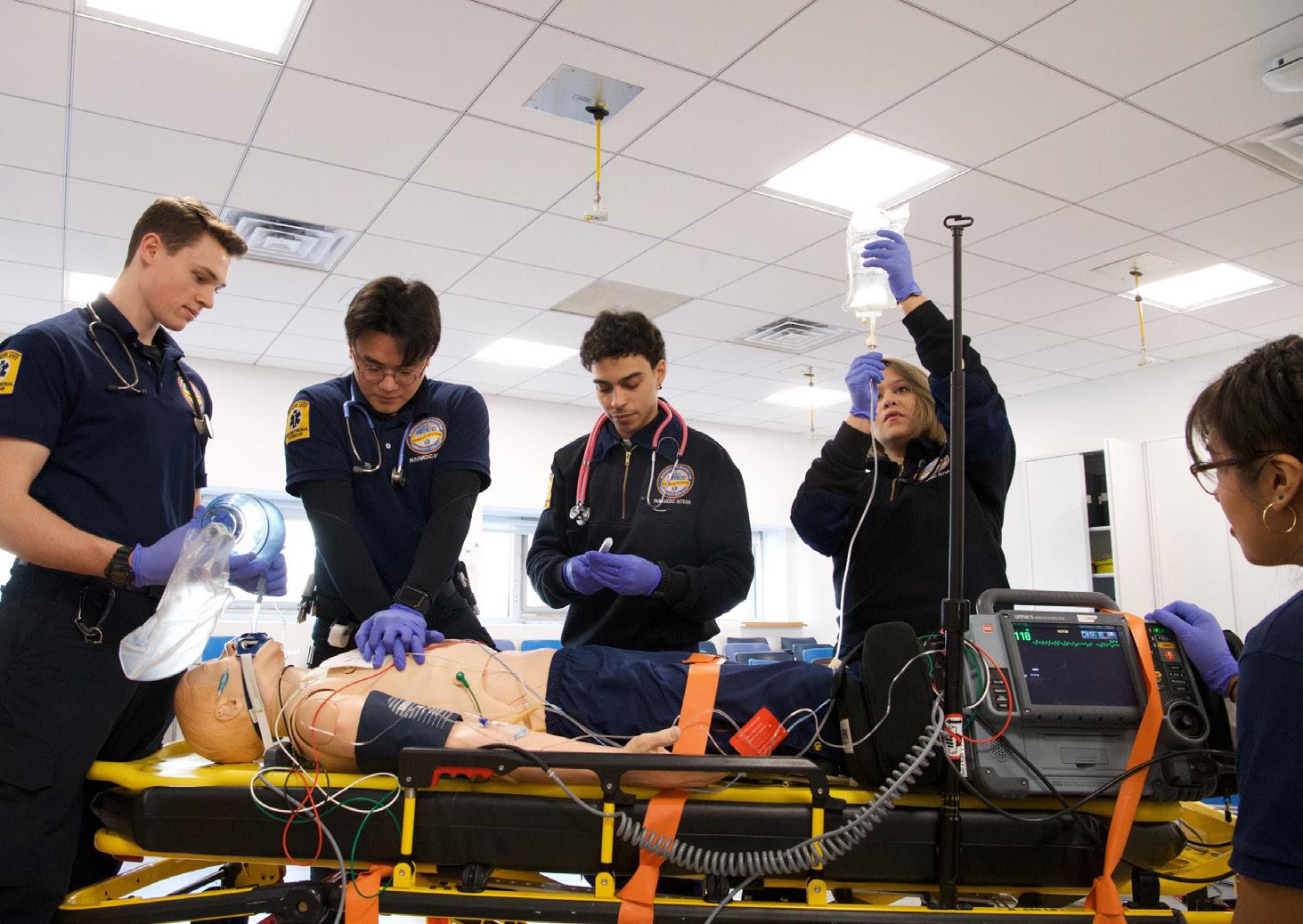
“




















Each year, counties are seeing an increase in the number of emotionally distressed individuals suffering from serious mental illness (SMI) and/or substance use disorder (SUD). Many of these individuals face extensive challenges on the road to recovery and require innovative solutions to address and support social determinants of health (SDOH).
Directors of Community Services (DCSs), otherwise known as the County Mental Health Department Directors or Commissioners, are statutorily responsible for the planning, development, and implementation of behavioral health treatment services through active coordination with state and local stakeholders. Many DCSs use Sequential Intercept Mapping (SIM) exercises to work with community partners to identify strategies that divert individuals with SMI and SUD away from the criminal justice system and into treatment.
a greater emphasis and flow of resources between Intercepts 0 - 1. Featured below are examples of how county mental health departments are collaborating with their local communities to advance this goal.
In Cattaraugus County, Care Coordinators are stationed in the local hospital’s Emergency Department. They work with individuals who have housing, social, medical, and other community needs, who are not being admitted psychiatrically, to connect them with outpatient treatment and local community services.
Sullivan County established a Mental Health Coordination of Care Committee that identifies gaps and barriers to access and assists first responders with diversion activities.
In Rensselaer County, training of law enforcement officers and the implementation of Crisis Intervention Teams (CIT) and
Highly successful community-based interventions have been developed for each of the intercepts pictured above, with the most attention being given to Intercepts 3-5. Pretrial services and supervision, specialty courts, jail-based mental health and addiction services programs that include coordinated reentry and discharge planning, and post-release support and collaborations with probation departments.

In order to promote overall wellness and recovery, as well as to prevent criminalization of individuals experiencing mental health and related concerns, DCSs across the state are working to implement and promote strategies that place
Emotionally Disturbed Persons Response Teams (EDPRT) has been a great asset at Intercept 1. Staffing includes an outreach clinician who conducts mental health and substance use disorder assessments, client engagement, provider referrals and peer support. Recently, the county’s largest municipal police department, in Troy, has trained nearly 100% of the officers in EDPRT. The county also launched a two-officer team that collaborates with providers and other community partners to engage individuals during an active offense, and who are known to the system.
In 2021, Albany County launched the ACCORD (Albany County Crisis Officials Responding and Diverting) program. ACCORD pairs a social worker from the County’s Mobile Crisis Team and a medic from the Sheriff’s Office to respond to a wide range of crisis calls and psychiatric emergencies, primarily in rural areas. ACCORD made national news with a case that resulted in the engagement with, and subsequent treatment of a homeless individual with serious mental illness, leading to their reunion with family after nearly 30 years.
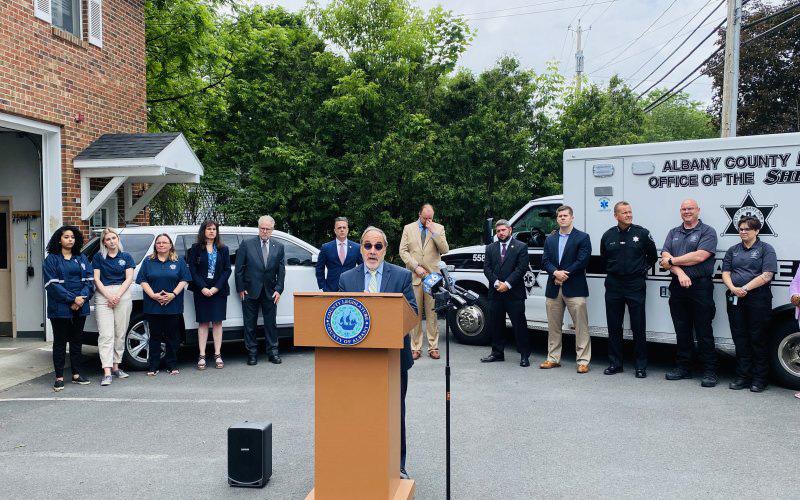
Both Clinton and Essex counties utilize the LEMHRS (Law Enforcement Mental Health Referral System). A LEMHRS referral is made when there is contact with a person experiencing behavioral health concerns, including overdoses. A trained coordinator monitors and assigns personnel to provide outreach to the identified individual who may agree to be linked with Care Coordination, MH, SUD Supports, or the Peer Provider System.
As part of the Niagara County PATH (Presenting Alternatives for Treatment and Healing) Team, the Quick Response to Overdose Team (QRT), comprised of a Certified Recovery Peer Specialist and a Qualified Health Professional, conducts outreach to individuals who survive overdoses and may also serve family members. Referred to as a "knock and talk," the QRT works to engage individuals, assess for, and assist with, a broad range of social, medical, and recovery support needs. The QRT remains available and engaged with individuals as long as a person is interested and will connect to treatment resources at an individual's request.
Lewis County created an Overdose (OD) Mapping Workgroup, which is comprised of substance use providers, corrections, drug task force members, EMS, and a peer agency and connects individuals and families who have recently experienced an overdose, with supports and services. A local peer agency receives a notification from their OD Mapping Dashboard and a rapid and proactive response is initiated for engagement.
Clinton County hosts an Imminent Risk Team (IRT) comprised of the FBI, the District Attorney, Sheriff’s Department, Plattsburgh City Police Department, NYS University Police at SUNY Plattsburgh, New York State Police, National Alliance on Mental Illness-Champlain Valley, HIDTA and the Community Mobile Crisis Team. The team meets regularly to identify individuals that pose a serious risk to themselves and/or the community and determines potential outreach opportunities to de-escalate the individual.
Orange County oversees the 311 Crisis Call Center that operates 24 hours a day, 365 days a year, and is co-located with 911 services and includes mobile response and peer support teams. Ten municipal police departments are trained in CIT, a peer co-location program is being piloted in the Port Jervis Police Department, and a HOPE NOT HANDCUFFS initiative between law enforcement and the community enables individuals struggling with SUD to seek assistance with any of the partnering organizations.
Each of these initiatives was developed as a result of DCS assessment of local need, in conjunction with community stakeholders. They have been successful due to being locally developed to address gaps while leveraging unique local resources.
The NYS Conference of Local Mental Hygiene Directors (“The Conference”) advances and communicates the DCSs expertise and voice working with state agencies, the Legislature, the Governor’s Office, and the Division of the Budget on state policy and funding initiatives.

Wayne County operates an Open Access Center which includes a mobile crisis team that engages individuals either in-person or by referral. The team works collaboratively with an OMHMobile Integration Team (MIT). The county mental health department has an additional team that assesses and monitors high-risk individuals to ensure follow-up.

In the year 2000, Nassau County faced a fiscal cliff. It had accumulated over $1 billion in tax certiorari liability and had no means to pay these obligations. The county was forced to ask New York State for assistance, which was granted in the form of the Nassau Interim Finance Authority (NIFA). NIFA is a state authority that issues debt on behalf of the county and intercepts county sales tax dollars to pay down the debt.

For almost two decades, Nassau County struggled to balance its budget and multi-year financial plan. High labor costs and debt obligations forced the county to reduce its workforce and make difficult decisions. To offset rising costs, the county also sought to develop new revenue streams and instituted cost savings initiatives such as outsourcing its bus and sewer operations to a private operator to realize expense savings.
In stark contrast to the dire circumstances twenty years ago, the county finished the 2021 fiscal year with a surplus of over half a billion dollars, 14 percent of its total operating budget. County Executive Bruce Blakeman strategically placed these surplus dollars into dedicated reserves to pay down the county’s liabilities and provide flexibility for future budgets.
In 2022, County Executive Blakeman negotiated a $250 million settlement on LIPA-owned properties that further reduced the county’s liability and submitted a balanced budget that added additional sworn officers to help keep Nassau County residents safe. Additionally, the county executive met personally with credit rating agencies to lay out his plan for strengthening the county’s finances, resulting in Nassau’s first bond upgrade in over a decade. He also has negotiated labor agreements that are fair and conform to the county’s multi-year financial plan.
With county finances in excellent condition, County Executive Blakeman now intends to focus on expanding the tax base, creating additional jobs for Nassau residents, and transforming the HUB property, which has been dormant for years. All these actions will have a positive impact on the county’s financial outlook and will fortify the strong fiscal position of Nassau County for decades to come.


The New York State Association of Counties' mission is to foster excellence in county government and unite the voice of New York’s county leaders.


Green power for local governments and municipalities.
Blended Power is competitively-priced to meet your needs, with up to 100% green energy. Buy this power from NYPA, and you also benefit from our years of power markets expertise. Talk with us about the best rate we have available to you. We can help manage your energy spend in this uncertain market. Power as only NYPA can deliver.













As we start 2023, we can’t possibly forget that our planet has been plagued by the effects of Covid-19 and its variants for nearly three years. The word Covid has taken on a life of its own and has dominated countless news cycles since the first outbreak. Our daily routines will never be the same and our way of life has been altered forever, with the stigma of COVID affecting everything we do and everywhere we go.
Ever since it appeared, Covid-19 has had a monopoly on news cycles. While new guidelines, ever-changing mandates, new variants, conflicting information, and a myriad of statistics dominated headlines, a stunning reality and ever-present epidemic lurked in its shadow.
Opioid overdoses and fatalities from overdoses rose over 30 percent. As people who were fighting addiction, in recovery, or using for the first time were forced to isolate, many had no way to interact with other people. Many returned to the only thing that could give them relief, but in a bigger and deadlier way. A 30 percent increase in deaths due to overdose in a pandemic is nothing short of frightening.
With money coming to counties from the various opioidrelated lawsuits against pharmaceutical companies, we are once again bringing the See the Signs, Save a Life campaign to the fore with new literature, TV ads, and support groups to help combat this deadly scourge, and to encourage people to seek the help that they need.
Each county in New York is receiving money to be used specifically to combat the opioid problem in various ways set forth in the grant protocols. From additional law enforcement to treatment programs and community support organizations, these funds will go a long way toward preventing overdose deaths.
Not only will they help provide Narcan training and Narcan kits, but more importantly, they will enable more effective ways to keep these drugs from getting into our communities and help provide more effective treatment to people suffering from addiction.
As a Chief Coroner in Orleans County, and as a NYS Licensed Funeral Director, I’ve seen firsthand the effects of opioid addiction and deaths due to overdose. Our funeral homes will be placing a retractable banner in our lobbies at each of our four locations offering free Narcan training by our staff and free kits provided through the Public Health Department.
The more people who get trained in this life-saving action; the more people who can possibly be saved from accidental death due to overdose.
I implore each county to step-up the prevention efforts and to use the grant money to reintroduce the See the Signs, Save a Life campaign throughout your county.
May we all be thankful for those who sacrificed to help stabilize our society during the pandemic. May we all remember those who are silently hurting and may need some additional support or mental health assistance. May we all learn how to “See the Signs” in hopes of perhaps being able to “Save a Life” in a world which is troubled by addiction more now than ever before. And may all of us remember how important it is to be understanding of the needs of others and to do our best to be kind in a hurting world.
For more information about the See the Signs: Save a Life campaign, contact Trellis Marketing at 716-8737199.

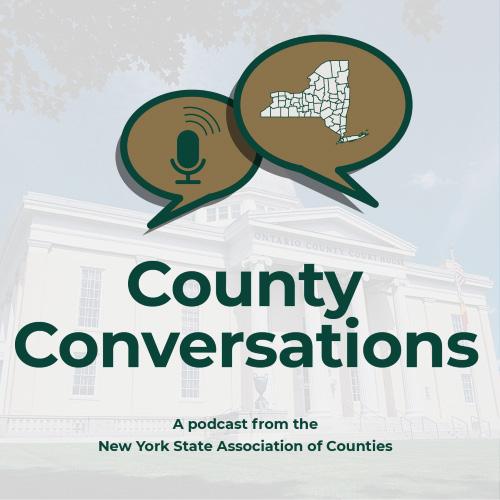

Visit


Each episode features discussions with leaders from across the state that are focused on providing innovative solutions to local issues.
Episodes range from 15 to 30 minutes long. You can listen in any order you would like, any time you like.
If there are any topics concerning county government that you would like to hear us discuss – or join as a guest to discuss – please email our Multimedia Specialist Kate Pierce-Nimz (kpierce@nysac.org) to turn your idea into soundwaves.





To date, forty-seven states and the District of Columbia have legalized some form of cannabis for recreational or medicinal purposes. In 2021, over $17 billion in legal cannabis was sold in the United States and we expect this number to grow over the next ten years to between $50 and $80 billion.
However, because this multi-billion-dollar industry operates almost exclusively in cash, it has become a prime target for criminal activity and places undue administrative burdens on counties who must process large cash transactions for licensing fees and taxes.
The bipartisan, bicameral Secure and Fair Enforcement (SAFE) Banking Act has been introduced in recent years in Congress and was passed by the U.S. House of Representatives over six times in the 117th Congress but ultimately was not passed by the U.S. Senate before the end of 2022. This important legislation would provide safety and certainty to the cannabis industry by providing access to checking accounts, loans and other services.
This legislation would also shield banks and insurers from federal penalties if they choose to provide services to legal and legitimate cannabis-related businesses.
When it comes to the SAFE Banking Act, we can’t lose sight of the fact that passing this legislation does not equal an endorsement of legalizing cannabis, the main point raised by opponents to the bill.
This is about prohibiting federal banking regulators from punishing banks for dealing with the cannabis industry, taking the cash out of cannabis and bringing the industry out of the shadows.
Counties have long supported greater access to banking services for legally sanctioned commercial cannabis activities to strengthen local public safety efforts.

While also eliminating a target for crime in our communities, lifting the administrative burden placed onto counties in processing cash transactions for fees and taxes would allow counties to reallocate resources and staff time to serve residents better.
The bill won’t solve public safety concerns overnight, and it won’t stop all violent crime against businesses in the industry. But it will reduce the likelihood of crimes in the states and counties where cannabis is regulated through responsible and robust regulatory programs.
We expect the SAFE Banking Act to be reintroduced in the early days of the 118th Congress and look forward to working with our congressional champions to advance the bill to ensure counties have the necessary resources to keep our local communities safe and secure.
This common sense legislation will provide much needed relief to the banking industry, county governments and the residents we serve on a daily basis.
Here’s to the only national Group Medicare Advantage plan rated 5 out of 5 Stars¹ for 2022 and 2023
Better health with over 2.1 million gaps in care closed over the past 12 months in our national Group Medicare Advantage plan²
Broad access to 943K+ Medicare participating providers nationwide, plus worldwide emergency coverage³
A no-cost, in-home visit from a health care practitioner each year with UnitedHealthcare® HouseCalls
1-on-1 clinical support for retirees with chronic conditions like diabetes, heart disease and more
1 Centers for Medicare and Medicaid Services, 2022 and 2023 Part C&D Medicare Star Ratings Data for UnitedHealthcare H2001 contract, Oct. 7, 2021 and Oct. 6, 2022. Medicare evaluates plans based on a 5-star rating system. Star Ratings are calculated each year and may change from one year to the next.
2 UnitedHealth Group internal data for all members on Medicare Advantage contract H2001.
3 Network Data and Analytics Report (NDAR), 2023.
Network size varies by plan and by market.
The HouseCalls program is not available with all plans and may not be available in all areas. Insurance coverage provided by or through UnitedHealthcare Insurance Company or its affiliates. Administrative services provided by United HealthCare Services, Inc. or their affiliates.
B2B EI222010645.0 1/23 © 2023 United HealthCare Services, Inc. All Rights Reserved. 22-2009456
515 Broadway, Suite 402
Albany, NY 12207
In 2013, MEGA partnered with Gravity Renewables to explore opportunities to reinvest in New York’s existing clean energy infrastructure.



Since then, our innovative program has resulted in millions of dollars in savings for our members and in reinvestment in hydropower projects that will benefit local communities for generations.

MEGA’s partnership with Gravity Renewables is one example of how clean energy strengthens communities, creating opportunities for
• Job Creation
• Recreation
• Historic Preservation
• Educational Outreach
• Emissions Reductions